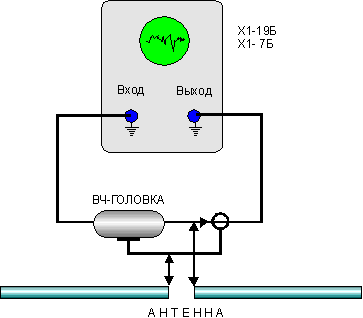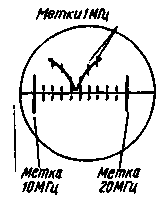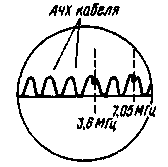Tuning antennas with a frequency response meter. Encyclopedia of radio electronics and electrical engineering

Encyclopedia of radio electronics and electrical engineering / HF antennas
 Comments on the article
Comments on the article
When establishing short-wave antennas, you can use the frequency response meter (X1-19B, X1-7B). Its output is connected to the input through the RF head (Fig. 1), and an antenna is connected to the connection points.

Ris.1
Tuning begins with determining the resonant frequency of the antenna. Depending on the type of antenna, either a "hump" (wave vibrator and other antennas with high input impedance at the resonant frequency) or a "dip" (half-wave vibrator, antennas derived from it) will be observed on the screen. By adjusting the antenna, they ensure that the maximum (minimum) of the curve on the frequency response meter screen coincides with the middle of the operating range. Frequencies are controlled by labels on the screen. An approximate view of the frequency response of the "Ground PIane" antenna (without feeder) for the 14 MHz band is shown in Fig. 2.

Ris.2
When looking at the characteristics of multi-element antennas, the "responses" from each element are clearly visible, which greatly simplifies the tuning process.
In this way, it is possible to measure not only directly at the antenna input, but also through a connected feeder, for example, a coaxial cable. At the same time, the total frequency response of the feeder and antenna is observed on the screen, which makes it possible, in the case of using a resonant feeder, to select its electrical length.

Ris.3
On fig. 3 shows an exemplary view of the "Inverted Vee" frequency response for the 3,5 and 7 MHz bands with a coaxial cable connected with a characteristic impedance of 50 ohms.
Authors: I. Kavetsky (UQ2G1G), S. Gokhberg (UQ2MU); Publication: cxem.net
 See other articles Section HF antennas.
See other articles Section HF antennas.
 Read and write useful comments on this article.
Read and write useful comments on this article.
<< Back
 Latest news of science and technology, new electronics:
Latest news of science and technology, new electronics:
Solidification of bulk substances
30.04.2024
There are quite a few mysteries in the world of science, and one of them is the strange behavior of bulk materials. They may behave like a solid but suddenly turn into a flowing liquid. This phenomenon has attracted the attention of many researchers, and we may finally be getting closer to solving this mystery. Imagine sand in an hourglass. It usually flows freely, but in some cases its particles begin to get stuck, turning from a liquid to a solid. This transition has important implications for many areas, from drug production to construction. Researchers from the USA have attempted to describe this phenomenon and come closer to understanding it. In the study, the scientists conducted simulations in the laboratory using data from bags of polystyrene beads. They found that the vibrations within these sets had specific frequencies, meaning that only certain types of vibrations could travel through the material. Received ... >>
Implanted brain stimulator
30.04.2024
In recent years, scientific research in the field of neurotechnology has made enormous progress, opening new horizons for the treatment of various psychiatric and neurological disorders. One of the significant achievements was the creation of the smallest implanted brain stimulator, presented by a laboratory at Rice University. Called Digitally Programmable Over-brain Therapeutic (DOT), this innovative device promises to revolutionize treatments by providing more autonomy and accessibility to patients. The implant, developed in collaboration with Motif Neurotech and clinicians, introduces an innovative approach to brain stimulation. It is powered through an external transmitter using magnetoelectric power transfer, eliminating the need for wires and large batteries typical of existing technologies. This makes the procedure less invasive and provides more opportunities to improve patients' quality of life. In addition to its use in treatment, resist ... >>
The perception of time depends on what one is looking at
29.04.2024
Research in the field of the psychology of time continues to surprise us with its results. Recent discoveries by scientists from George Mason University (USA) turned out to be quite remarkable: they discovered that what we look at can greatly influence our sense of time. During the experiment, 52 participants took a series of tests, estimating the duration of viewing various images. The results were surprising: the size and detail of the images had a significant impact on the perception of time. Larger, less cluttered scenes created the illusion of time slowing down, while smaller, busier images gave the feeling of time speeding up. Researchers suggest that visual clutter or detail overload can make it difficult to perceive the world around us, which in turn can lead to faster perception of time. Thus, it was shown that our perception of time is closely related to what we look at. Larger and smaller ... >>
 Random news from the Archive Random news from the Archive Sunny Seville
01.06.2007
In the Spanish province of Seville, a solar power plant with a capacity of 11 megawatts has been launched. More than a hundred mirrors follow the Sun and concentrate its light on a steam boiler, which is mounted on top of an 80-meter tower.
Steam rotates a turbine with an electric generator, as in a conventional thermal power plant. There is a thermal accumulator, which allows not to stop the operation of the station for an hour if a cloud has come up. Seville usually has 320 sunny days a year.
The solar power plant will be further expanded and by 2010 will turn into a complex with a total capacity of 302 megawatts.
|
 Other interesting news:
Other interesting news:
▪ Eewrite Janus tablet with E Ink and LCD screens
▪ Rats detect tuberculosis
▪ Electrical stimulation of the brain allows you to make fewer mistakes
▪ Siberian tundra under the threat of destruction
▪ Crystal is 1,6 times stronger and harder than diamond
 News feed of science and technology, new electronics
News feed of science and technology, new electronics
 Interesting materials of the Free Technical Library:
Interesting materials of the Free Technical Library:
▪ section of the site Interesting facts. Selection of articles
▪ article The bony hand of hunger. Popular expression
▪ Article Why do people have such different hair? Detailed answer
▪ article Intellectual property appraiser. Job description
▪ article Masses of liquid resins. Simple recipes and tips
▪ article Philips DVDQ50 DVD player switching power supplies. Encyclopedia of radio electronics and electrical engineering
 Leave your comment on this article:
Leave your comment on this article:
 All languages of this page
All languages of this page
Home page | Library | Articles | Website map | Site Reviews

www.diagram.com.ua
2000-2024







 Arabic
Arabic Bengali
Bengali Chinese
Chinese English
English French
French German
German Hebrew
Hebrew Hindi
Hindi Italian
Italian Japanese
Japanese Korean
Korean Malay
Malay Polish
Polish Portuguese
Portuguese Spanish
Spanish Turkish
Turkish Ukrainian
Ukrainian Vietnamese
Vietnamese



 Leave your comment on this article:
Leave your comment on this article: